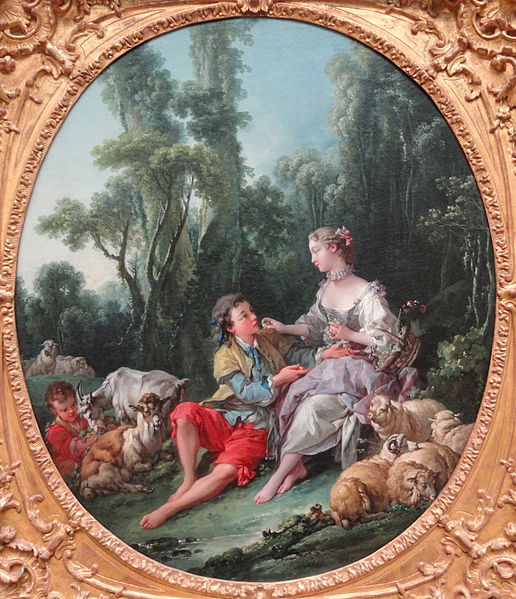
Members: 









Dictionary: (all members)
 Грожђе/Суво грожђе
Грожђе/Суво грожђе  Drue/rosin
Drue/rosin  виноград/ родзинка / vynohrad / rodzynka /
виноград/ родзинка / vynohrad / rodzynka / Struguri
Struguri
 hroznové víno/ hrozinky
hroznové víno/ hrozinky  kurdzeni/ყურძენი
kurdzeni/ყურძენი  Грозде/стафиди
Грозде/стафиди
 A) Description, varieties, aroma, taste,...
A) Description, varieties, aroma, taste,...
 B) Real and Art Picture (+ information about the artist)
B) Real and Art Picture (+ information about the artist)

This is a painting called feeding Grapes and was painted by François Boucher. He was a French painter, draughtsman and etcher, who worked in the Rococo style. Boucher is known for his idyllic and voluptuous paintings on classical themes, decorative allegories, and pastoral scenes.Wikipedia
Born: 29 September 1703, Paris, France
Died: 30 May 1770, Paris, France
Period: Rococo
 C) In 10 steps how to grow a grape/raisin
C) In 10 steps how to grow a grape/raisin
 D) In which countries worldwide is it grown (produced)? Cultivation history
D) In which countries worldwide is it grown (produced)? Cultivation history
 E) Import and export in Europe Flavia Rus
E) Import and export in Europe Flavia Rus

 F) Prices in Europe/ world
F) Prices in Europe/ world


 G) Recipes with grapes/raisins
G) Recipes with grapes/raisins
 by Yaryk Litvin, School 5, Monastyryshche, Ukraine
by Yaryk Litvin, School 5, Monastyryshche, Ukraine
 by Denys Shcherban,
by Denys Shcherban,
 H) Science experiment 1: Search a science experiment suitable for a grape/raisin. Each of the responsible schools does the experiment, and compares the results. (you can invite every person in your group to do the experiment)
H) Science experiment 1: Search a science experiment suitable for a grape/raisin. Each of the responsible schools does the experiment, and compares the results. (you can invite every person in your group to do the experiment)
 I) Science experiment
I) Science experiment

2: Foodpairing : grapes/raisins in combination with another (vegetable or fruit )
 J) Health benefits and Nutrional values:
J) Health benefits and Nutrional values:
Grapes health benefits and nutritional values
On average, Americans eat eight pounds of grapes a year! Grapes’ nutritional value and health benefits are also undeniable. Not only are grapes delicious as a snack or in a meal, they also contain fibre. Fibre adds bulk to your diet and can help keep you feeling satisfied throughout the day. Moreover, fibre-rich foods such as fruits help provide a feeling of fullness with fewer calories.
GRAPES
The ways to consume grapes are endless- from red, green and purple grapes to seedless grapes, grape jelly, grape jam and grape juice. And don't forget wine and raisins! This popular fruit's history goes back as far as 8,000 years, when grape vines were first cultivated in what is now the Middle East.
It may surprise you to hear that the humble grape is actually considered to be a berry. Seventy-two million tons of these berries are grown each year worldwide, with most of them being used to produce wine - 7.2 trillion gallons of wine per year, to be exact.The portability, texture, flavour and variety of grapes have made them a popular finger food in countries all over the world. The potential health benefits of consuming grapes are numerous, with past studies associating them with prevention of cancer, heart disease, and constipation, and hiogh blood pressure.
A grape is a fruit, botanically a berrry, of the deciduous woody vines of the flowering plant genus.
Grapes can be eaten fresh as table grapes or they can be used for making wine, jam, juice, jelly, grape seed extract,raisins, vinegar, and grape seed oil. Grapes are a non-climacteric type of fruit, generally occurring in clusters.
According to the Food and Agriculture Organization, 75,866 square kilometres of the world are dedicated to grapes. Approximately 71% of world grape production is used for wine, 27% as fresh fruit, and 2% as dried fruit. A portion of grape production goes to producing grape juice to be reconstituted for fruits canned "with no added sugar" and "100% natural". The area dedicated to vineyards is increasing by about 2% per year.
Raisins
A raisin is a dried grape. Raisins are produced in many regions of the world and may be eaten raw or used in cooking, baking, and brewing. In the United Kingdom, Ireland, New Zealand, and Australia, the word "raisin" is reserved for the dark-coloured dried large grapes with "sultana" being a golden-coloured dried grape, and "currant" being a dried small Black Corinth seedless grape.
Raisins can contain up to 72% sugars by weight, most of which is fructose and glucose. They also contain about 3% protein and 3.7%–6.8% dietary fibre. Raisins, like prunes and apricots, are also high in certain antioxidants, but have lower vitamin C content than fresh grapes. Raisins are low in sodium and contain no cholesterol.
Data presented at the American College of Cardiology's 61st Annual Scientific Session in 2012 suggest that, among individuals with mild increases in blood pressure, the routine consumption of raisins (three times a day) may significantly lower blood pressure, especially when compared to eating other common snacks
Group 1 - Potatoes Group 2 - Red Cabbage Group 3 - Spinach Group 4 - Carrots
Group 5 - Pumpkin Group 6- Lemon Group 8 - Orange
Group 9 - Kiwi Group 10 - Banana Group 11 - Beans